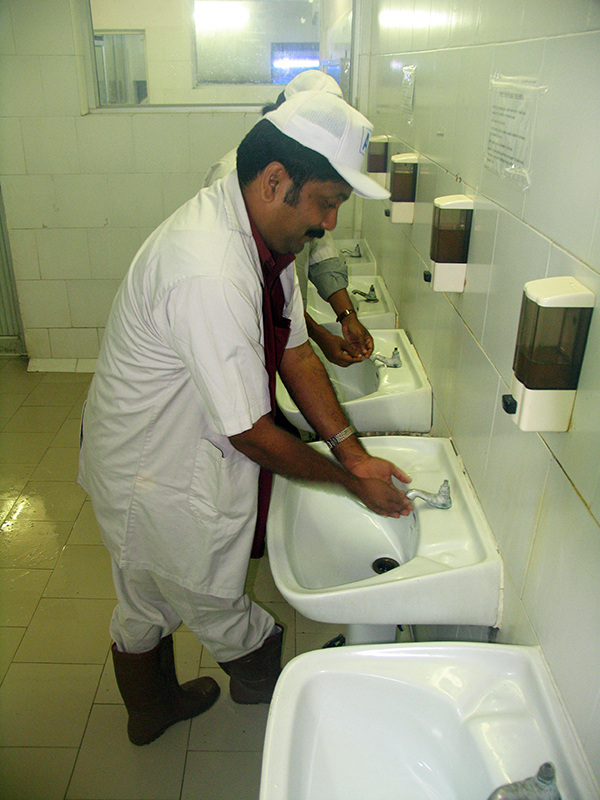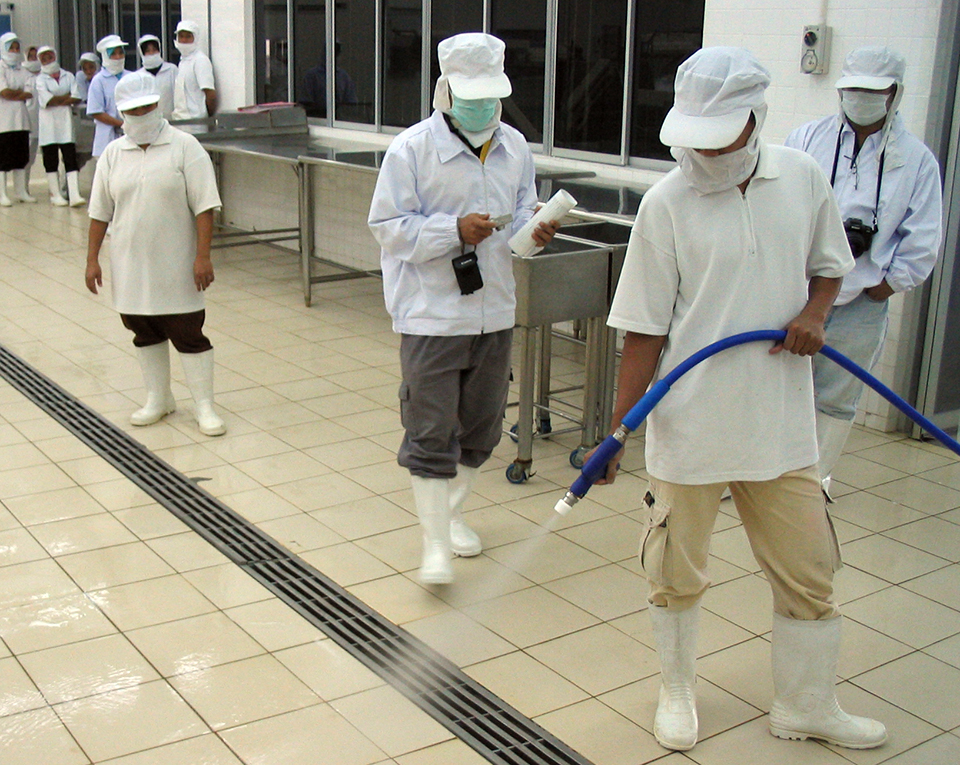Measures must include equipment, ponds and personnel

Biosecurity in aquaculture involves a series of actions designed to maintain the health of aquatic animals by reducing the introduction of pathogens to facilities, and if that fails, reducing the spread of pathogens within the facilities. The vectors that introduce these pathogens vary somewhat with indoor recirculation systems and outdoor ponds.
Biosecurity procedures prevent pathogen entry through disinfection, sanitary practices, security measures, and disease monitoring. But how effective are these procedures? Are they equally effective in all situations, or do they merely give a false sense of security?
Personnel biosecurity
Biosecurity measures for personnel and visitors typically involve foot baths, hand disinfection, protective clothing and access restriction.
Although foot baths are commonly used in indoor aquaculture facilities, they can be breeding grounds for bacterial and mold contamination if they are not monitored daily. Stepping into foot baths with dirty shoes can rapidly neutralize the disinfectant and allow the shoes to become conduits of spread. Contact time spent walking through foot baths is usually limited to a few seconds, which is not adequate to kill most pathogens. Dedicated footwear or disposable foot covers may be a better option.
Hand disinfection, also a common practice in indoor/outdoor facilities, must be practiced correctly to be effective. Contact time is important. If using soap and water, a 30-second scrub is recommended. Alcohol sanitizers are extremely effective, less messy than soap and water, and eliminate the need to dry hands due to their quick drying time.
Wearing protective clothing, such as disposable clean suits or lab coats, is a good practice for visitors or personnel entering isolation or quarantine areas, but are of little value in typical aquaculture operations. Restricting visitor access to designated areas is often necessary. Visitors often do not understand the importance of biosecurity measures practiced by personnel and are not as likely to adhere to them.
Incoming equipment
Vehicular disinfection is often practiced at outdoor facilities. This usually involves driving delivery trucks or farm equipment through vats containing iodine or chlorinated water. Just as with foot baths, contact time is typically inadequate. If tire treads are caked with dirt or mud, the disinfectant will be ineffective. In addition, chlorine dissipates rapidly in warm water and is neutralized by organics tracked into the vats. It would be more effective to hose off the tires to remove any caked debris and then spray them with a suitable disinfectant.
Chlorine
Many disinfectants can be used to clean tanks prior to restocking, but chlorine is the most common. Typically tanks are scrubbed, rinsed, refilled with chlorine-treated water and stocked after dechlorination. However, not all pathogens are killed by chlorination. Drying out or rotating tanks can increase the effectiveness of chlorine treatments, but generally interferes with production.

Clean water
A “clean” water supply is of utmost importance. There are a number of ways to disinfect water, with chlorination the most used method. Chlorine can kill culture animals as well as pathogens, so care must be taken in neutralizing the chlorine with sodium thiosulfate.
Ultraviolet (UV) filtration is often used to treat the water in which broodstock, larvae, and fry are reared. UV is safer than chlorine, but more expensive. It only works effectively when the correct wattage is determined for the density and flow rate used in the culture system. With UV treatment, it is also necessary to clean the quartz sleeves and/or change the bulbs on a regular basis. Bulbs may light up beyond the time they effectively emit UV light.
Pond biosecurity issues
Ponds biosecurity must deal with pests such as birds, crustaceans, fish and insects – all of which are known vectors of disease. Common practices include exclusion through filtration, scaring, shooting, or nets. Although all of these practices are effective to some extent, biosecurity in outdoor facilities can never equal that of indoor facilities. However, the effort should certainly be expended outdoors to limit problems as much as possible.
Disease monitoring
Disease monitoring often involves testing for suspected pathogens by polymerase chain reaction (PCR) coupled with quarantine and clinical evaluation. PCR is a sensitive molecular biological technique that can detect the presence of pathogens before they become problems. Before larvae or fry are purchased, the broodstock from which they came should be tested for diseases of concern.
Reputable hatcheries associate with diagnostic laboratories that periodically test their animals. Hatcheries should keep documentation that indicates which tests were conducted and when. There have been reports of false positives and/or negatives, but the number is very low, and reputable labs retest samples for confirmation. If buyers have doubts, have the offspring tested.
Quarantine
Quarantine is necessary to prevent the spread of unsuspected diseases within established facilities. The most common problem associated with the practice is the amount of time in which animals are kept in quarantine. Certain parasitic pathogens with three-week life cycles can be present at such low levels that they are missed upon initial examination. Therefore, four-week quarantine periods are advocated.
Quarantine facilities must be designed so that each tank has its own filtration system. Quarantine areas need to be placed as far away from the rest of the operations as possible. Strategic planning by personnel is needed, as well.
Quarantine facilities must be the last place visited. Even if the donning of protective clothing and hand disinfection are properly practiced, staff should never return to rearing areas after visiting quarantine areas. Prior to adding the quarantined arrivals to areas inhabited by other animals, a second examination for suspected pathogens is recommended.
Conclusion
Biosecurity can be highly effective. It has allowed the aquaculture industry to move forward in the face of new diseases. Biosecurity is well worth the cost and effort required to implement it, but only if biosecurity practices are truly effective and not merely window dressing.
(Editor’s Note: This article was originally published in the October 2004 print edition of the Global Aquaculture Advocate.)
Now that you've finished reading the article ...
… we hope you’ll consider supporting our mission to document the evolution of the global aquaculture industry and share our vast network of contributors’ expansive knowledge every week.
By becoming a Global Seafood Alliance member, you’re ensuring that all of the pre-competitive work we do through member benefits, resources and events can continue. Individual membership costs just $50 a year. GSA individual and corporate members receive complimentary access to a series of GOAL virtual events beginning in April. Join now.
Not a GSA member? Join us.
Author
-
Susan E. Laramore
Assistant Director
Aquatic Animal Health Lab
Harbor Branch Oceanographic Institution
5600 U.S. 1 North
Fort Pierce, Florida 34946 USA
Tagged With
Related Posts

Health & Welfare
A comprehensive look at the Proficiency Test for farmed shrimp
The University of Arizona Aquaculture Pathology Laboratory has carried out the Proficiency Test (PT) since 2005, with 300-plus diagnostic laboratories participating while improving their capabilities in the diagnosis of several shrimp pathogens.

Health & Welfare
A holistic management approach to EMS
Early Mortality Syndrome has devastated farmed shrimp in Asia and Latin America. With better understanding of the pathogen and the development and improvement of novel strategies, shrimp farmers are now able to better manage the disease.

Health & Welfare
A look at aquaculture in Guyana
With its large quantities of water and little industry to pollute it, Guyana has the potential to become a greater player in global aquaculture.

Responsibility
A look at various intensive shrimp farming systems in Asia
The impact of diseases led some Asian shrimp farming countries to develop biofloc and recirculation aquaculture system (RAS) production technologies. Treating incoming water for culture operations and wastewater treatment are biosecurity measures for disease prevention and control.


